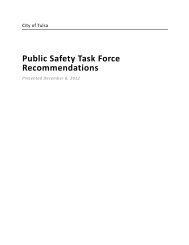Vision TULSA - The Tulsa City Council
Vision TULSA - The Tulsa City Council
Vision TULSA - The Tulsa City Council
Create successful ePaper yourself
Turn your PDF publications into a flip-book with our unique Google optimized e-Paper software.
By Kim Jones <strong>Tulsa</strong> Air and Space Museum & Planetariumaviation & aerospaceJimmie Jones I- <strong>The</strong> first aircraft built in <strong>Tulsa</strong> in 1906.Aerospace…It’s who we are!Although <strong>Tulsa</strong> was settled by Creek Indians in the1830s and later populated by pioneers movingwest on foot, horseback, and wagon, the turn ofthe 20th century would see these people castingtheir gazes skyward. Our city’s first documentedaviation event was 1897’s manned smoke balloonascension at the Independence Day celebration atthe fairgrounds in downtown <strong>Tulsa</strong>. It was a portentof great things to come for the young cow town.<strong>Tulsa</strong>’s first locally built airplane was designed andconstructed by a West <strong>Tulsa</strong> resident Jimmie Jones.In 1906, only three short years after the WrightBrothers first successful flight, Jimmie beganbuilding his creation. Having seen pictures of aircraftin magazines and newspapers, he designed his shipto resemble those being built in Europe at the time.Unfortunately Jimmie’s aircraft was blown away ina good old Oklahoma thunderstorm before he hadthe chance to fly it. Judging from the two knownphotographs of the craft, it probably saved his life.When oil was discovered in the <strong>Tulsa</strong> area in1901 the new pioneers (oilmen) arrived by thetrainload. After World War I, many of the oilmenwould purchase surplus airplanes to use in theirbusinesses. <strong>The</strong>y could fly to the far reaches ofwestern Oklahoma or Texas and secure an oil leasebefore others could even get their automobilesstarted. As a result, the oilmen were big promotersof aviation in the early days. One oilman, WilliamGrove Skelly, was into aviation in a big way. Hefounded the Spartan Aircraft Company and theSpartan School of Aeronautics. He located hisaircraft company just south of the newly built <strong>Tulsa</strong>Municipal Airport and his school was located on thesouth end of the airport. <strong>The</strong> year was 1928 and itsignaled the beginning of <strong>Tulsa</strong> as an aviation city.During the 1930s, <strong>Tulsa</strong> was a popular stopoverfor aviators from all over the country. It was oneof the stops on the 1929 Women’s Air Derby,dubbed <strong>The</strong> Powder Puff Derby by Oklahoma’sfavorite son, Will Rogers. This recognition by theelite of aviation would become important as warclouds began brewing in Europe and Asia. In1940, it became known to the <strong>Tulsa</strong> Chamber ofCommerce that the War Department was goingto build a series of aircraft manufacturing plantsthroughout the Midwest where they would be safefrom enemy bombardment. Once the city fathersfound out, they began making weekly flights toWashington, D.C., lobbying for one to be builtin <strong>Tulsa</strong>. In part due to the recognition of <strong>Tulsa</strong>as an aviation town, the government relented. If<strong>Tulsa</strong> could provide the land, they would build theplant. <strong>Tulsa</strong>ns passed a $750,000 bond issueto purchase land adjacent to the <strong>Tulsa</strong> MunicipalAirport. By March of 1941, ground would be brokenon what was officially called Air Force Plant #3 butwhich <strong>Tulsa</strong>ns simply called, <strong>The</strong> Bomber Plant.In conjunction with AFP #3, a modification centerwas built just north of the plant to keep up withthe ever-changing technology in military aviation.During World War II, the plant and the ModCenter were operated by the Douglas AircraftCompany. Thousands of bombers were builtand modified during the four years of WorldWar II. <strong>The</strong> plant and the Mod Center wereclosed at the end of the war in 1945. In 1946,American Airlines moved their maintenance basefrom New York to <strong>Tulsa</strong> and set up shop in therecently closed Mod Center. <strong>The</strong> bomber plantwas reopened in 1951 to start final assembly onAmerica’s first strategic jet bomber, the B-47.By the late 1950s, Douglas <strong>Tulsa</strong> was enteringthe space age with work on missiles and rockets.<strong>The</strong>y were instrumental in helping create the Deltarocket, one of the most successful rocket programsin history. On May 25, 1961, President JohnKennedy addressed a joint session of Congressand declared that the country should dedicate itselfto putting a man on the moon and returning himsafely to earth by the end of the decade. <strong>The</strong> verynext day, <strong>Tulsa</strong> held the first Conference on thePeaceful Uses of Space at the fairgrounds, bringingtogether scientists and engineers from all aroundthe world. By the following year, North AmericanAviation would lease space from the DouglasAircraft Company to begin setting up the SaturnV Assembly Area where they would manufacturesignificant parts of all of the Saturn V rockets thatwould eventually take Americans to the moon.As the Apollo program began to wind down,Rockwell <strong>Tulsa</strong> turned its attention to the SpaceShuttle program. All the orbiter payload bay doorsand much of the ground handling equipment weremanufactured in <strong>Tulsa</strong>. <strong>The</strong> shuttle would be theheavy-hauler to transport the huge parts for theconstruction of the International Space Station. Bythe late 1980s, Boeing Company began ramping upfor support of the ISS program. Eleven of the hugetruss structures that connect the various habitationmodules of the ISS were built in <strong>Tulsa</strong>. Alsomanufactured here were the integrated electricalassemblies that orient the giant solar panels tothe sun to provide power to the space station.<strong>Tulsa</strong> is home to companies such as AmericanAirlines Maintenance and Engineering Center,Spirit Aerosystems, NORDAM, Flight SafetyInternational, L-3, Honeywell and Safety TrainingSystems, as well as hundreds of smaller companiesthat provide parts and services to the aerospaceindustry. With <strong>Tulsa</strong>’s aerospace businesses anduniversities delving into the field of UnmannedAerial Vehicles (UAVs), <strong>Tulsa</strong>’s aerospace futurelooks bright. Building upon the century-long legacyof <strong>Tulsa</strong>’s early aviation pioneers and with the vastinfrastructure that was created during their tenurewe can truly say, Aerospace…It’s who we are!58 VISION <strong>TULSA</strong> 2012 | t u l s a c o u n c i l . o r g





